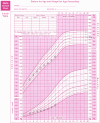Assessing growth in children and adolescents with Avoidant/Restrictive Food Intake Disorder
- PMID: 38877582
- PMCID: PMC11177361
- DOI: 10.1186/s40337-024-01034-8
Assessing growth in children and adolescents with Avoidant/Restrictive Food Intake Disorder
Abstract
Background: Although growth delays and disruption are a well described medical complication of restrictive eating disorders in children and young adolescents, this complication has received less attention in patients with Avoidant/Restrictive Food Intake Disorder (ARFID). Patients with ARFID have challenges with adequacy of food volume and variety that are not related to body image but are instead related to lack of interest in eating, sensory concerns, and/or fears of aversive consequences. Because onset of ARFID is commonly before puberty, concerns regarding growth adequacy may present an additional treatment challenge and a unique opportunity for support.
Review: Child and adolescent patients with other restrictive eating disorders are at risk of irreversible deleterious impact on growth and development, particularly when onset is before or around puberty. Although faltering growth is a defining feature of ARFID, less attention has been paid to methods for examining growth concerns in young patients with ARFID and training providers to assess growth adequacy when prepubertal and peripubertal patients present with this diagnosis. Providers working with patients under 18 years of age with eating disorders will benefit from the tools discussed in this narrative review to adequately assess growth and development against genetic potential, recognize alterations in growth that are a result of nutritional deficiencies, and support and maximize catch-up growth and development when it has been impaired.
Conclusion: Established pediatric growth monitoring tools and techniques to assess adequacy of growth can be applied to child and adolescent patients presenting with ARFID. These tools can improve long term outcomes in linear height for these patients and allow for monitoring during and after treatment until growth and development is complete. Medical providers caring for patients presenting with ARFID will need to establish best practices for assessing and monitoring growth.
Keywords: ARFID; Eating disorders; Growth and development.
© 2024. The Author(s).
Conflict of interest statement
The authors declare no competing interests.
Figures
Similar articles
-
Avoidant restrictive food intake disorder: recent advances in neurobiology and treatment.J Eat Disord. 2024 Jun 7;12(1):74. doi: 10.1186/s40337-024-01021-z. J Eat Disord. 2024. PMID: 38849953 Free PMC article. Review.
-
The factor structure and validity of a diagnostic interview for avoidant/restrictive food intake disorder in a sample of children, adolescents, and young adults.Int J Eat Disord. 2022 Nov;55(11):1575-1588. doi: 10.1002/eat.23792. Epub 2022 Aug 18. Int J Eat Disord. 2022. PMID: 36324295 Free PMC article.
-
Clinical and psychological features of children and adolescents diagnosed with avoidant/restrictive food intake disorder in a pediatric tertiary care eating disorder program: a descriptive study.J Eat Disord. 2018 Apr 27;6:7. doi: 10.1186/s40337-018-0193-3. eCollection 2018. J Eat Disord. 2018. PMID: 29736239 Free PMC article.
-
Modification of an inpatient medical management protocol for pediatric Avoidant/Restrictive Food Intake Disorder: improving the standard of care.J Eat Disord. 2023 Sep 22;11(1):165. doi: 10.1186/s40337-023-00895-9. J Eat Disord. 2023. PMID: 37737186 Free PMC article.
-
Assessment and Treatment of Avoidant/Restrictive Food Intake Disorder.Curr Psychiatry Rep. 2023 Feb;25(2):53-64. doi: 10.1007/s11920-022-01404-6. Epub 2023 Jan 14. Curr Psychiatry Rep. 2023. PMID: 36640211 Free PMC article. Review.
Cited by
-
Avoidant/restrictive food intake disorder-like syndrome and cerebellar tumor in an adolescent: a case report.J Eat Disord. 2025 Mar 3;13(1):41. doi: 10.1186/s40337-025-01195-0. J Eat Disord. 2025. PMID: 40033396 Free PMC article.
-
Orthodontic Treatment in Patients With Epidermolysis Bullosa (EB)-Clinical Practice Guidelines (CPG).Spec Care Dentist. 2025 Sep-Oct;45(5):e70084. doi: 10.1111/scd.70084. Spec Care Dentist. 2025. PMID: 40899465 Free PMC article.
References
Publication types
LinkOut - more resources
Full Text Sources




